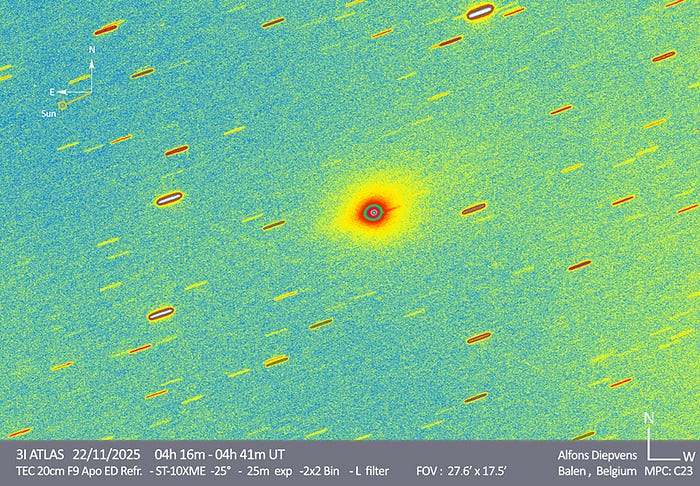
A false-color image of 3I/ATLAS, taken on November 22, 2025. The sunward direction is towards the lower left. (Credit: Alfons Diepvens, Belgium)
Avi Loeb
The time is ripe to summarize the anomalies of the interstellar object 3I/ATLAS in ascending order of likelihood. Here is the list, split into three categories, along with the probability, P, associated with each item:
I. Major anomalies with no simple explanation:
1. P=0.00004: The forecasted perijove distance of 3I/ATLAS during its encounter with Jupiter on March 16, 2026 is 53.445 (+/- 0.06) million kilometers, identical to Jupiter’s Hill radius, 53.502 million kilometers (see here). This match was enabled by the non-gravitational acceleration that 3I/ATLAS displayed near perihelion. The rare coincidence might mean that 3I/ATLAS intends to release technological devices as artificial satellites of Jupiter, potentially at Jupiter’s Lagrange points L1 and L2 at the Hill radius — where orbital corrections and fuel requirements are minimal
2. P=0.00005: The arrival time of 3I/ATLAS was fine-tuned to bring it within tens of millions of kilometers from Mars, Venus and Jupiter and be unobservable from Earth at perihelion (see here).
3. P<0.001: The nucleus of 3I/ATLAS is roughly a million times more massive than 1I/`Oumuamua and a thousand times more massive than 2I/Borisov, while moving faster than both (see here and here). There is not enough rocky material in interstellar space to deliver a rock of this mass once per decade to the inner solar system (see here). This suggests that 3I/ATLAS may have targeted the inner solar system rather than was drawn at random from the reservoir of interstellar rocks.
4. P<0.001: During July and August as well as through November of 2025, 3I/ATLAS displayed a sunward jet (anti-tail) that is not an optical illusion from geometric perspective, unlike thousands of known comets (see here). The HiRISE image taken at closest approach of 3I/ATLAS to Mars, confirmed a glowing extension ahead of 3I/ATLAS along the direction of motion (see here). For a technological object, a beam of light or particles might be used to mitigate the risk from micrometeorites or rocks that could impact its surface at a relative speed of order 60 kilometers per second and release a thousand times more energy per unit mass than explosives.
5. P<0.001: The gas plume surrounding 3I/ATLAS contains much more nickel than iron as found in industrially-produced nickel alloys, and a nickel to cyanide ratio that is orders of magnitude larger than for thousands of known comets, including 2I/Borisov (see here). This might indicate an artificial origin of these unusual abundances.
6. P=0.002: The retrograde trajectory of 3I/ATLAS is aligned to within 5 degrees with the ecliptic plane of the planets around the Sun (see here). This suggests that the trajectory may have been designed.
II. Medium anomalies, which could be a statistical fluke:
1. P=0.006: 3I/ATLAS arrived from a direction coincident with the radio “Wow! Signal” to within 9 degrees (see here).
2. P<0.01: 3I/ATLAS shows extreme negative polarization, unprecedented for all known comets, including 2I/Borisov (see here). This unusual polarization may be related to its unusual anti-tail.
III. Minor anomalies, which could potentially be explained by a unique origin:
1. P<0.1: The gas plume surrounding 3I/ATLAS contains only 4% water by mass, a dominant constituent of familiar solar-system comets (see here). The plume might have resulted from the sunlight releasing the ices and dust that accumulated on the surface of a technological object during its journey through the cold interstellar medium.
2. P<0.1: Near perihelion, 3I/ATLAS brightened faster than any known comet and was bluer than the Sun (see here). This might be a signature that its engine turned on.
3. P<0.1: 3I/ATLAS exhibits sunward and anti-solar jets which require an unreasonably large surface area for a natural comet in order to absorb enough sunlight needed to sublimate enough ice to feed the mass flux of these jets (as calculated here). The jets might originate from technological thrusters.
4. P<0.1: The tightly-collimated jets from 3I/ATLAS maintain orientation across a million kilometers in multiple directions relative to the Sun despite its measured rotation. The jets might originate from technological thrusters.
5. P<0.1: Near perihelion 3I/ATLAS exhibits non-gravitational acceleration which requires massive evaporation for a natural comet (as calculated here), whereas preliminary images indicate that the object maintained its integrity and did not break up (as discussed here). Instead, the acceleration might have been produced by an engine.
***
The probability for the combined occurrence of multiple independent anomalies is the product of their individual probabilities. From the above list, it is apparent that 3I/ATLAS is an extremely rare and mysterious object, especially if it happens to be a natural comet as argued by NASA officials at the press conference on November 19, 2025 (accessible here).
Regarding the updated ranking of 3I/ATLAS on the Loeb Scale (as defined here and here), I would prefer to wait for the flood of new data in the coming weeks before revising my previous value.
In an interview on NewsNation last night (accessible here), the brilliant Natasha Zouves asked me what data am I most looking for in the coming weeks. I explained that a spectroscopic measurement of the speed and composition of the jets of 3I/ATLAS would reveal whether they stem from the sublimation of pockets of ice on the surface of a rock or from technological thrusters.
____
https://avi-loeb.medium.com/anomalies-of-3i-atlas-organized-by-likelihood-af20fb3b6d21
